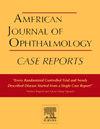Delayed diagnosis of glaucoma in Coffin-Siris syndrome
Q3 Medicine
引用次数: 0
Abstract
Purpose
To report a case of delayed diagnosis of glaucoma in a patient with Coffin-Siris Syndrome (CSS) who did not have any other predisposing risk factors or typical anterior segment signs of congenital glaucoma.
Observations
A 27-year-old male with CSS was referred to the ophthalmology department for evaluation of strabismus. Past ocular history included a diagnosis of right morning glory anomaly and bilateral hyperopic astigmatism. Initial exam in the clinic was notable for visual acuity of 20/80 in the right eye and 20/40 in the left eye. Given difficulty with exam in the outpatient setting, the patient underwent exam under anesthesia. Intraocular pressures (IOPs) were 38 mmHg OD and 23 mmHg OS at induction and gonioscopy was significant for high iris insertion and prominent iris processes in both eyes. On dilated fundus exam, the right eye had a severely pallorous and cupped optic nerve; the left eye was also cupped but less so. Elevated IOPs and nerve cupping was consistent with a diagnosis of glaucoma.
Conclusions and importance
Patients with CSS may develop glaucoma and should be screened for this important ophthalmic association, even in the absence of external signs of pediatric glaucoma including an enlarged cornea, anterior segment dysgenesis, or other risk factors for glaucoma such as steroid use.
Coffin-Siris综合征青光眼的延迟诊断
目的报告1例无其他易感危险因素或典型先天性青光眼前段征象的Coffin-Siris综合征(CSS)患者被延迟诊断为青光眼。观察1例27岁男性CSS患者转诊至眼科进行斜视评估。过去的眼部病史包括诊断为右侧牵牛花异常和双侧远视散光。初诊右眼视力20/80,左眼视力20/40。鉴于门诊检查困难,患者在麻醉下接受检查。诱导时眼内压(IOPs)为38 mmHg OD和23 mmHg OS,眼膜镜检查对双眼虹膜高位插入和虹膜突突出具有重要意义。眼底扩张检查显示右眼视神经严重苍白、杯状;左眼也被封住了,但没那么严重。眼压升高和神经拔罐符合青光眼的诊断。结论和重要性:CSS患者可能发展为青光眼,应筛查这一重要的眼科相关性,即使没有儿童青光眼的外部体征,包括角膜扩大、前段发育不良或其他青光眼的危险因素,如使用类固醇。
本文章由计算机程序翻译,如有差异,请以英文原文为准。
求助全文
约1分钟内获得全文
求助全文
来源期刊

American Journal of Ophthalmology Case Reports
Medicine-Ophthalmology
CiteScore
2.40
自引率
0.00%
发文量
513
审稿时长
16 weeks
期刊介绍:
The American Journal of Ophthalmology Case Reports is a peer-reviewed, scientific publication that welcomes the submission of original, previously unpublished case report manuscripts directed to ophthalmologists and visual science specialists. The cases shall be challenging and stimulating but shall also be presented in an educational format to engage the readers as if they are working alongside with the caring clinician scientists to manage the patients. Submissions shall be clear, concise, and well-documented reports. Brief reports and case series submissions on specific themes are also very welcome.
 求助内容:
求助内容: 应助结果提醒方式:
应助结果提醒方式:


